In Sodom, 2018
Me and Waylon at Salix's Birthday Party. The only baby in the tribe who will let me hold him without wailing. In Sodom.
In Sodom, 2018
Me and Waylon at Salix's Birthday Party. The only baby in the tribe who will let me hold him without wailing. In Sodom.
Morris Norton playing the tune bow, Sodom, Madison County, NC 1977
Hanging around in Sodom in the mid-1970s, one was sure to meet Morris Norton. He was in his early 80s at that point, cantankerous, not working much, but fit enough to wander around the community dispensing wisdom and opinion. I thought of him as the unofficial Mayor. He fathered many children, ten or twelve I think, mostly boys, most of whom were the nicest people you'll ever meet. Morris played at music, picking a banjo and playing harp. He could flat-foot dance pretty well for an old guy. He also made and played tune bows, an instrument I had never seen before, similar in sound to a jews harp. It's old and basic, but in the hands of a skilled player could put out a rollicking lick and keep people on the dance floor.
Two or three years after first coming to Sodom, I was in Maryland visiting family and took a day trip to the Smithsonian Museum of American History. Wandering through the numerous and incredibly detailed displays I came to one on early American music. There was a section on instruments and there in front of me was a tune bow, accompanied by a tag that read: Tune bow made by Morris Norton, Sodom, North Carolina. I remember thinking, "Wow. I know this guy." But with the thought came an understanding that History isn't just the grand events, the things and people we know from books and the classroom, but also involves the lives of everyday people.
One of Morris's sons, Emmett, is a singer/songwriter who regularly plays on Friday nights at the Depot in Marshall. Not too many years ago, he approached me and handed me a tune bow. Identical to one his father might have made, he offered it as a gift to me, his signature on the inside face - a piece of local history and, for me personally, something that evoked memories of a photograph, a man and his family, and an instrumental time in my life.
Molly Chandler and her son, Starlin, Sodom, Madison County, NC 1977
Joe Chandler with two of his sons-in-law, Conley Goforth (left) and Vince Vilcinskas,
Sodom, Madison County, NC 1977.
On the Revere-Rice Cove Road, Sodom, Madison County, NC 2016
Donna Ray Norton, Sodom, Madison County, NC 2016
I had the good fortune to spend a few hours this past Sunday with Donna Ray Norton at her childhood home in Sodom. Donna is one of a small group of young people who continue to sing the ancient ballads that Madison County and Sodom are noted for. She is an 8th generation ballad singer and has a voice to die for. You can listen to her on this video that was produced by the Knoxville News Sentinel about seven years ago.
https://www.youtube.com/watch?v=89g5hg-LpJM
In 1916, Cecil Sharp, the British musicologist, arrived in Madison County with his assistant, Maud Karpeles, where he collected more ballads than anywhere else in his travels through the southern mountains. He famously claimed that people in Madison County were more comfortable singing than speaking. His work resulted in the definitive volume: English Folk Songs from the southern Appalachians, which was published in 1934. This fall Mars Hill University will mount an exhibition to celebrate the Cecil Sharp Centennial as part of their annual Bascom Lamar Lunsford Festival, which will run from September 26 to October 21, 2016, with an opening reception on October 1 from 5-6 pm during the Festival.
Debbie Chandler brushing her grandmother's, Dellie Norton, hair, Sodom, Madison County, North Carolina, 1991
I've been thinking a lot about Dellie .
I'm not sure why today.
Most days I see photographs of her hanging in my studio
so it's not like she isn't around. She is.
But for some reason, today, she's popped in my mind and stayed.
I'm fine with that.
This photograph was made about two years before she died.
She had been in declining health for a couple of years prior.
Here, after a stay in the hospital, back home,
with family members taking turns in her care.
Perhaps that's why she's stayed with me today.
Because of our own situation caring for Leslie's mom.
Watching her age, needing more and more,
content to sit and be quiet.
Me knowing, it won't be long.
Berzilla Wallin, Sodom, Madison County, NC 1975
Little Granny they called her. And,
by the time I met her in 1975, she was 83, and truly little.
Married to Lee, a job in itself from what I understand,
although I never met the man.
Mother to ten kids, I believe, might have been twelve.
She was a farmer and singer of the old ballads.
The whole family sang as did most families back then.
But the Wallins got some notoriety from it.
Pictures on album covers. Collectors. Young people coming around.
Invitations to sing at big places.
Sons Jack and Doug had their own album and
Doug was something of a legend.
Many consider him to be the best, period.
But he'd tell you he got it all from his mother,
Little Granny, the Matriarch,
his best friend he told me many times,
who he stayed with 'til she died,
never marrying,
never spending a night away.
David Holt on the set of Amazing Grace, America in Song, at Dellie Norton's home, Sodom, Madison County, 1975
I’ve known David Holt a long time. I reminded him the other day I was at his first known concert – a very intimate affair in the basement of the old Pack Library in downtown Asheville. There were maybe ten of us in the audience and his wife, Ginny Callaway, accompanied him on guitar. David asked me how bad it was and I told him that given my complete lack of knowledge of old-time music I thought it was great.
As most of us know, David has improved his musical skills quite a bit over the years as evidenced by his multiple Grammy awards and worldwide following. He can be seen on public television and continues to play concerts for significantly larger audiences than that first early attempt. Most importantly in my mind, has been David’s work over the years to perpetuate the genre of folk music and his unflagging support for young musicians.
David Holt in his art studio in the River Arts District, Asheville, NC 2014
What many people don’t know is David is also an accomplished photographer. For most of his music career, he has photographed people he considers his mentors – from Doc Watson to Dellie Norton to Ralph Stanley. Some of his images are presently on view at the Madison County Arts Council in Marshall and they are well worth a visit. He’s hoping to publish these photographs, and many more, in book form some time in future.
Last week I stopped to visit David at his studio space in the River Arts District in downtown Asheville. There, David showed me some of his latest work – paintings that incorporate the photographs along with words about the musicians. These are a new direction for him and I could tell immediately how much fun he was having. "David gone wild," I commented. It was a great visit with an old friend.
Clinton Norton Waiting for the School Bus, Sodom, Madison County, NC 1977
Rob Amberg's essay for the 5 part Oxford American Symposium titled Portraying Appalachia.
http://www.oxfordamerican.org/articles/2014/mar/26/living-creek/
Marion and Dennis Chandler Heading into the Rice Cove, Madison County, NC 1978
We’re going to cook and heat the house with wood. My friends across the mountain in Sodom are a family of loggers and they have a sawmill and an excess of wood. They offer a truckload of firewood as a welcoming gift. One Saturday we bounce up the side of a mountain on the back of a flat-bed truck, barely able to hold on. We cut an enormous load of mixed hardwoods, which we load onto the back of the truck. Some of the sawed pieces are huge, and heavy, and I wonder how long it will take me to bust them into burnable size. When we go to pull out, the truck is mired in the soft ground and won’t budge. We unload it, piece by piece, move the truck a few feet, and reload the wood. Everyone gets a good laugh. I was exhausted by the double effort.
Melanie and the Jumping Cat, Sodom, Madison County, NC 1975
I hadn’t seen Melanie Rice Penland in some time before running into her, her husband Nate, and their son Ezra at a party a couple of weeks ago. Seeing her reminded me of a photograph I made almost forty years ago. Melanie’s mom, Sheila Kay Adams, had taken me up to Dellie Norton’s house for the first of my many visits with Dellie and her family. Sheila had her young daughter with her and I was immediately smitten. Melanie had a presence even then at three or four years old. Direct, bold, and self-assured.
Children are among the hardest subjects for photographers. It’s relatively easy to picture youguns as cute and playful, the apples of our eyes. And they seem to know exactly how we want them to look - endearing, irresistible, and ultimately cute. But making an image that gets beyond the smiling superficialities and into the heart of the child is a different matter. In this case Melanie, with her open and patient gaze, made it easy.
Doug Wallin, Folk Festival, Cullowhee, North Carolina
It’s hard to think of Doug Wallin and not smile. One of my first times around him, I helped him and his brother Jack hang tobacco in the barn next to their cabin on Crain Branch. Doug was high in the barn, moving between the top two tier poles. I was new to the work and he didn't want me handling the heavy sticks of burley while up too high in the barn. After we got into a rhythm with the passing of the tobacco, Doug began singing. His voice echoed from the tin roof and filled the barn with his unique soft voice, eloquent phrasing and unaffected style. It gave me goosebumps and made me smile back then and does the same thing now as I write about it.
Doug always made me smile. He was a bit of a jokester and player of pranks as his father, Lee Wallin, was noted to be. He had a song to fit most any occasion and reputedly knew over 300 ballads and songs. Doug could be cantankerous and suspicious and he didn't suffer fools or what he perceived as disrespect. When his mind was made up about something or someone, he wouldn't change it. He would quickly drop an offender from his life. He was an incredibly gifted singer, many say the best Madison County has ever produced.
I was fortunate in that Doug’s mother Berzilla, Dellie Norton's 83 year old sister, really liked me. Her daughter Berthie once said her mother used to daydream about me, which I find amazing and flattering given our 55 year age difference. As is the case in any community that celebrates family as Madison County does, my relationship with Berzilla carried over to Doug and over the years we grew fond and comfortable with each other.
Years later, after Berzilla died, and Jack was needing increased attention at the VA Hospital in Asheville, the brothers moved to a small apartment near the Marshall bypass. As much as I loved spending time at the cabin, listening to music and stories, eating, working, sitting on their porch, my favorite memory is from the time when they were living in town.
Doug Playing Fiddle for Kate, Crain Branch, Madison County, North Carolina, 1992
I stopped at Ingles on the way home today. I had Benny and Kate with me and walking through the canned food aisle we ran into Doug and Jack who were doing their weekly shopping. We visited for a time and talked briefly of their lives in town. I begged off, needing to get the kids home and fed, and told them I’d come by soon for a visit. As we turned to go, Doug and Jack both reached into their pants pockets and pulled out their wallets. They each found two one-dollar bills and ceremoniously presented one to each of the kids - a gesture so stunning in its simplicity and sheer goodwill.
We always celebrated Memorial Day when I was growing up - a day of remembrance and thanks that always included a visit to the cemetery to place flowers on the graves of family members who had served in the military. The visitation was usually followed by a picnic and barbecue back at the house. Memorial Day also marked the beginning of summer vacation.
Grave Decoration at the Rice Cove Cemetery, Madison County, NC 1977 from Sodom Laurel Album
I was introduced to grave decorations when I moved to Madison County and they were different than I was used to. I learned that each of the hundreds of small family cemeteries in the county has its own unique Decoration Day – all held on Sundays between Memorial Day and Labor Day. Prior to the actual Decoration Day, family members would tend to the cemetery – mow the grass, rake the grave mounds, and remove last year’s plastic flowers. On the appointed Sunday, relatives would gather first at someone’s house for a reunion and dinner and then move to the cemetery to honor the deceased and to listen to preaching. This wasn’t the case with every cemetery in the county – some were only mowed and others weren’t touched at all.
I went to the Decoration at the Rice Cove cemetery this past Sunday. I was last there in 1977 when I had gone at the invitation of Bonnie Chandler who hosted a huge meal and reunion at her house. I made photographs at the reunion and cemetery, a number of which were included in my book, Sodom Laurel Album. Bonnie’s children and their spouses continue the tradition today and Sunday’s meal was every bit the feast it was when Bonnie was alive.
Preaching and Witnessing at the Rice Cove Cemetery Grave Decoration, Madison County, NC 2013
What struck me about the day was how little it had changed from thirty-six years earlier. Yes, faces were different – some older with more lines and wrinkles; some faces not there; other new faces in their place. The massive tree in the cemetery was bigger, offering even more shade and respite from the heat of the day. And there were certainly more graves. The road to the cemetery was improved and easy to negotiate, even with all the rain. But the placing of flowers, the singing of hymns, and the preaching and the saving were old and comfortable rhythms, as they were meant to be. In this time of seemingly constant and drastic change, it was reassuring to be in a place where the rituals and traditions remained constant.
Grave Decoration, Rice Cove Cemetery, Madison County, NC 2013
Junior and Pet, Sodom, Madison County, NC, 1978
Shu, Paw Paw Creek, Madison County, North Carolina, 2012
Photographs by Rob Amberg
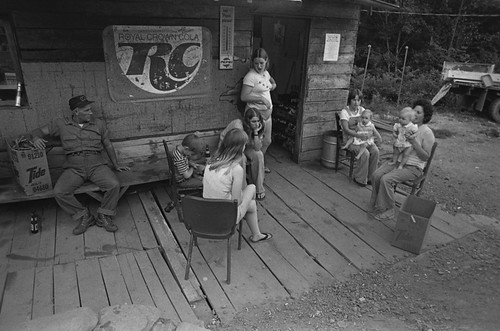
At Ramsey's Store, Sodom, Madison County, NC 1977
At Cricket's Birthday Party, Big Pine, Madison County, NC 2011
As a documentary photographer living and working several decades in Madison County, North Carolina, Rob Amberg has chronicled the lives and stories of people in isolated mountain areas such as Sodom. The photographs exhibited in Madison County - Past and Present include some of Amberg's oldest as well as most recent work demonstrating thechanging culture of Appalachian North Carolina.www.robamberg.com
Opening Reception: Friday, June 14, 6-8pm in the Nicholson Gallery
The exhibition runs from June 3-30.
http://www.artscenterlive.org/exhibition/exhibit
The opening reception on June 14 will feature a performance by noted Madison County ballad singer and storyteller Sheila Kay Adams. Adams was just awarded the prestigious National Heritage Fellowship from the National Endowment for the Arts, which is widely considered the highest honor for the Arts in the nation.
Sheila Kay Adams, Sodom, Madison County, NC 1975
I was introduced to the Sodom community of Madison County by Sheila Kay Adams. Sheila was a student at Mars Hill College back in 1975 and I had just begun working at the newly established photo archive at the college. I remember speaking with Sheila about the difficulty gaining access to a small mountain community where I could hang out and make pictures. Sheila offered to take me to her home community of Sodom to meet her great aunt, Dellie Chandler Norton. It would prove to be an offer that would irrevocably change my life and influence everything I’ve done since.
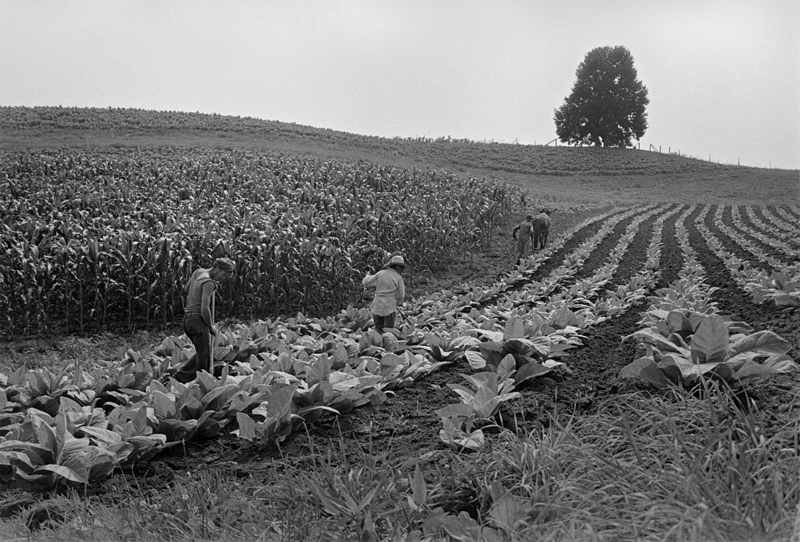
Isaac and Robbie Gunter and their son working tobacco, Sodom, Madison County, NC, 1975.
On our first trip to Sodom together, we passed an older couple and a young man working in a tobacco patch. The older man was plowing the clean and elegant rows with a horse. The other two people were hoeing and pulling the loose, freshly plowed soil around each individual plant. There wasn’t a weed to be seen and the deep green plants were thriving from the personal attention.
Lacking self-confidence and any understanding of local mores, I never would have stopped had I been on my own. But Sheila was the perfect bridge. She knew Isaac and Robbie Gunter and after introducing me and explaining who I was and what I was doing, they readily agreed to pose for photographs.
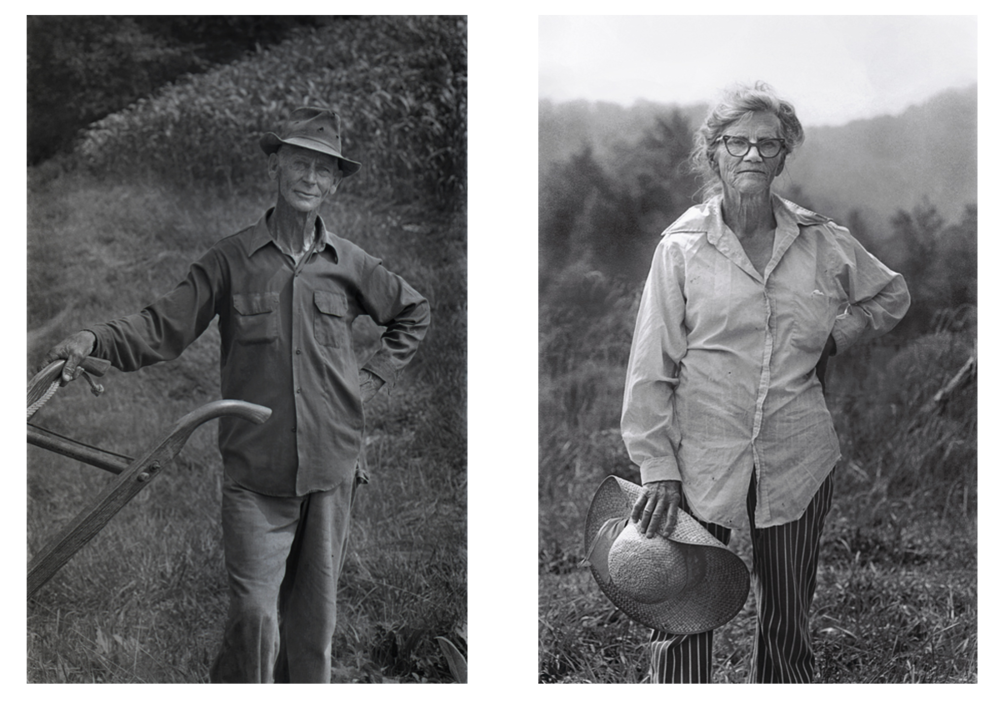
Isaac and Robbie Gunter, Sodom, Madison County, NC, 1975.
Seen from the eyes of a young documentarian thirty-eight years ago - someone new to the community, coming from a very different place, who didn’t yet know the importance of spending time with people - the photographs felt like wary introductions when I made them. I knew they were nice portraits, but formal and static. They lacked the energy and movement I wanted in my photographs back then and the images never made it beyond the contact sheets.
But a photograph’s meaning can change for all of us over time. Looking at these photographs now with the eyes of someone much older – as old as the Gunters were when I made their pictures - I see something different. I see two people comfortably presenting themselves to the camera in a relaxed and open manner. I see people assured in their posture and confident in who they are. I see the strength and grace in their life-worn faces and hands. And what I once perceived as a formal introduction, I now recognize as a personal invitation into their world.

Robbie's Memorial built by her son Michael, and Isaac and Robbie's Grave and Marker,
Sodom, Madison County, NC, 2013.
I took this photograph of Tillman Chandler in 1975 and have never exhibited or published it. There are reasons I’ve kept it hidden away all these years, just as there are reasons now for bringing it to the light.
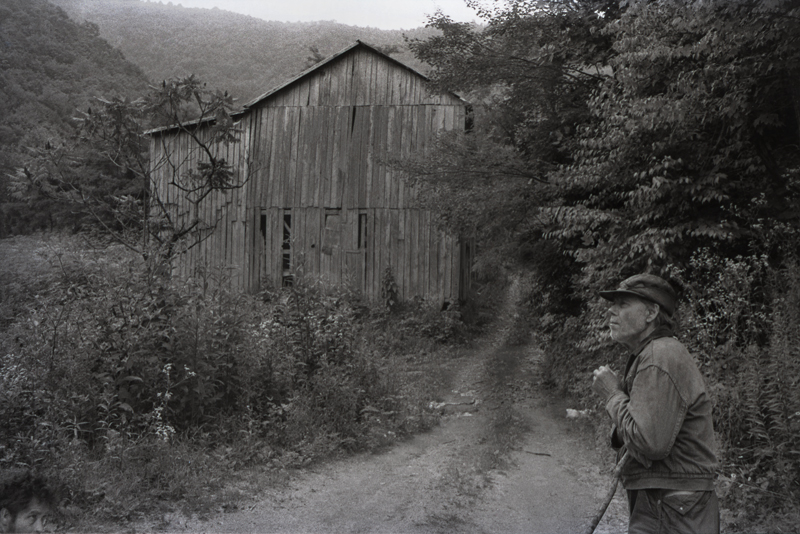
Tillman Chandler and Junior, Sodom, Madison County, NC, 1975.
I was new to Sodom back then – probably my second or third stay with Dellie and her adopted son Junior - and I was still finding my way in the wider community, something I couldn’t have done without Dellie and her extended family providing access. One day Dellie suggested that Junior take me to meet Tillman who was Dellie’s cousin and a tobacco farmer who lived alone in a cabin on top of the mountain. Tillman’s brother was Dillard Chandler, the noted ballad singer and protagonist of John Cohen’s film The End of An Old Song, but where Dillard was known to be out and about, Tillman rarely left home.
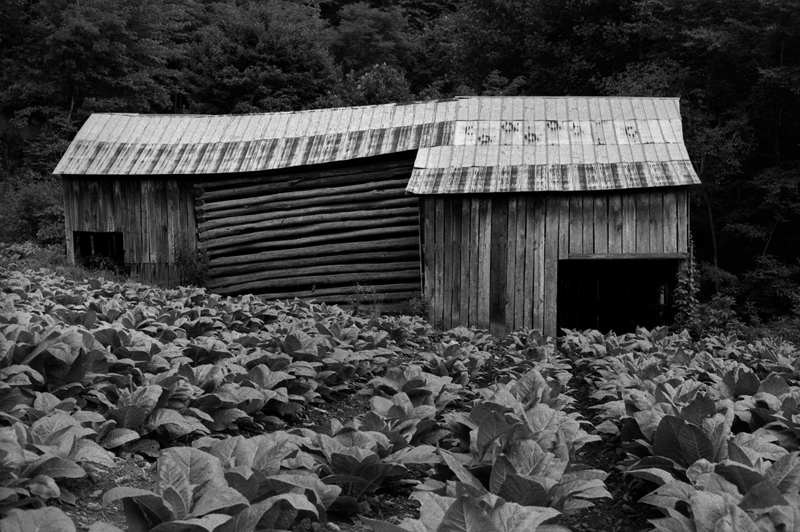
Tillman's Barn and Tobacco, Sodom, 1975. from Sodom Laurel Album
Tillman was there when we arrived, and friendly as I recall, but he wouldn’t let me photograph him. I could photograph around his place, but not him. We stayed an hour or more and I made some pictures of his tobacco and barns. Walking to my car, I turned to thank him and saw this picture. This was in the days of manual-everything cameras, but I estimated the shutter and aperture settings and pre-focused the lens. I steadied myself, and the camera, and pressed the shutter. I liked the image when I saw it, but felt it lacked energy and it was easy enough to set it aside. But more importantly, there was the matter of my stealing the picture after he had asked me not to and I knew I’d never do anything with it no matter how much I liked it.
I saw Tillman infrequently after that. No one saw him much. He would walk the couple of miles to Rube Gosnell’s store every two or three weeks, pick up some corn meal and feed, a few groceries, some snuff, and walk back to the cabin. A couple of years later folks hanging out at the store realized they hadn’t seen him in a few weeks and decided to go up there. They found him on the floor of the cabin, obviously dead for some time as rats had eaten his body. His bones were still garbed in overalls, shirt, and hat. Reportedly, there were thousands of dollars in cash stuffed into the hat’s brim.
Our young friends Kelsey and Tommy have been looking at a piece of land over in Sodom recently and mentioned there was a small graveyard on the property with someone named Tillman Chandler in it. That prompted me to find the old negative and scan it. From the barn in the background, they confirmed it was the place they were interested in.
For me, Documentary Expression should be a reflection of both the subject and the artist. While I had the image open In Photoshop, I saw a piece of the picture I had never noticed before - Junior’s head in the lower left corner. Those eyes – fixed and riveting – mimicking my own fear and nervousness as I shot the single frame. That simple element – Junior’s eyes – prompted my own memory and brought back the tension and guilt at the moment I made the photograph, and the energy I thought the photograph lacked in the first place.
But what of the ethics of publishing the picture now, years after Tillman’s death? Not only did I take his picture without permission years ago, but now I’m posting it.
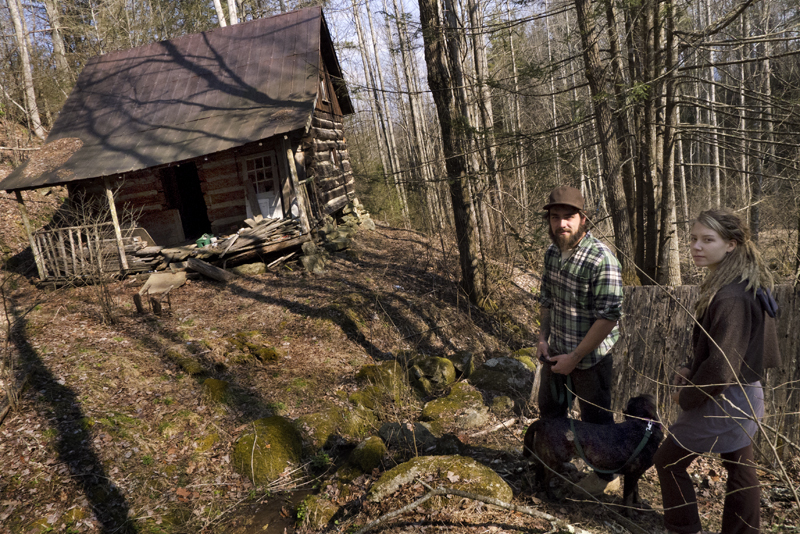
Kelsey, Tommy, and Maci at Tillman's old cabin, Sodom, Madison County, NC, 2013.
Kelsey, Tommy, and I walked up to the cabin last week. It was different than I remembered it. We hiked up the side of the mountain to the gravesite and found it covered with brush and small saplings. There was an unmarked stone beside Tillman’s marker that Dellie’s granddaughter, Jane Goforth, felt was his mother or father, or both. We had wondered how they got the bodies to this isolated spot, alone in the woods, a steep climb from the house. From Jane, “Tillman is buried with his mother and Father. There are some other graves. I don't know who they are. It is probably more family members. Tillman is not buried there in his original grave. The weather was so bad that winter they buried him behind the house. They went back the first of April and moved him on up the ridge with his parents. They had to carry him up on a sled.”
I think there is merit in the story, something to be learned that is hard not to share and shouldn’t be ignored. Photography is about memory. It reminds us of people and places from our past, and our present, and helps us understand the particulars of our lives – how we got from there to here. When I look at this photograph of Tillman today, I see an old man holding a cane staring out to an unseen distance. He would be dead less than two years later. There’s a barn, and a dirt road, with a mountain range in the background. It’s serene, and quiet, and I want to believe Tillman, and his family, would think it was a good likeness of him. A likeness worth remembering.
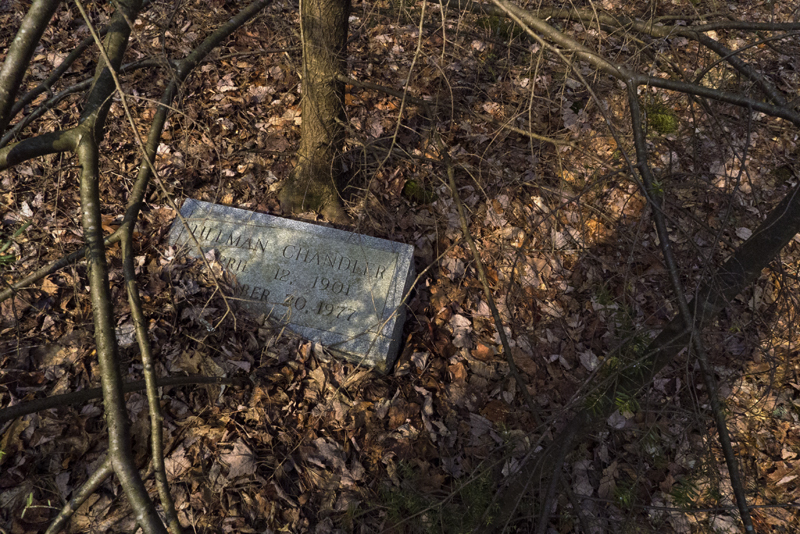
Tillman's Grave, Sodom, Madison County, NC, 2013.
Especially with the added words, the photograph paints a picture of place and people. In 1975, there were few remaining people like Tillman Chandler - fiercely independent, raising tobacco for a little cash money, who lived and died by himself on the side of a mountain. I think the photograph and story speak to our shared history of place, as well as, the personal past of the Chandler family, which I hope makes it worth sharing.
